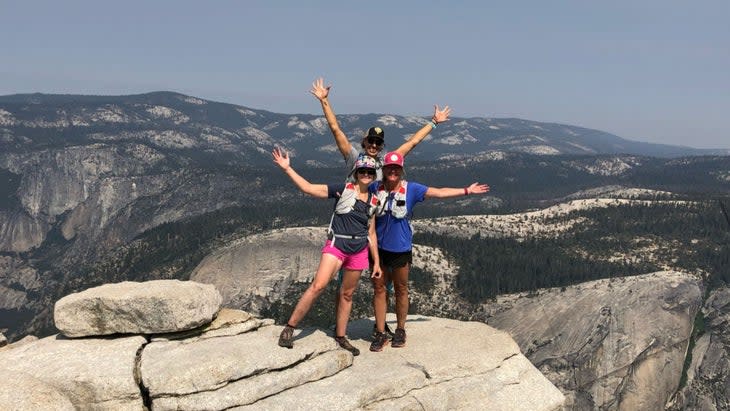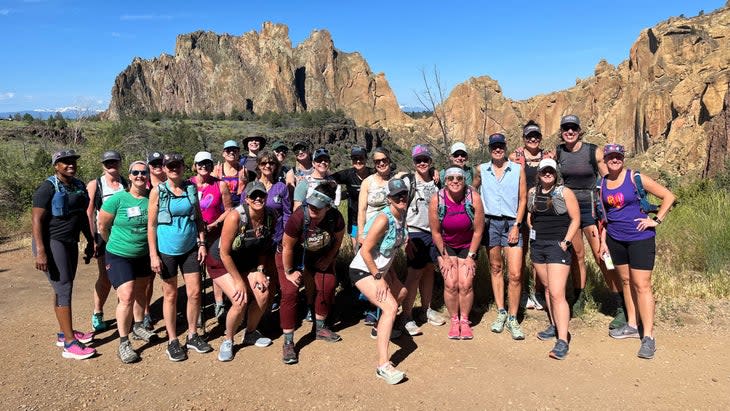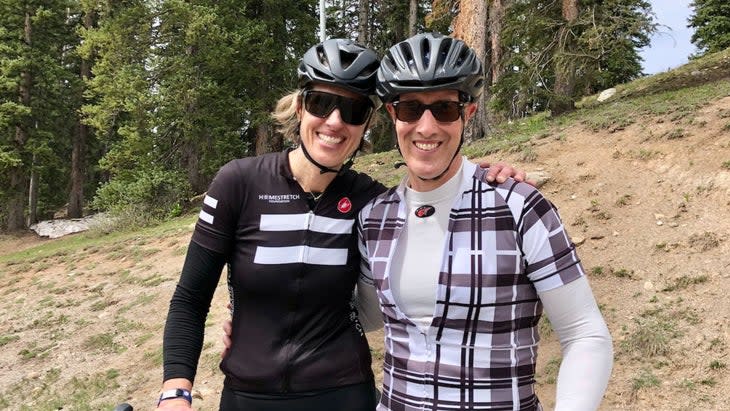How to Replace Running
This article originally appeared on Womens Running
This article is part of our ongoing series at Women's Running by Dimity McDowell, offering support to runners who can no longer run.
In less than five minutes, you change your clothes, grab your earbuds, double knot your shoes, and off you go. That's running: simple and efficient.
Touring your neighborhood around 6 mph is usually an ideal way to sort your thoughts and quiets your anxiety, build your aerobic capacity and carve your calves. That's also running: an impressive payback for just a few miles.
But when you can no longer run--and you come to grips with letting go of it for good--it feels like your access to the endorphin express lane has been permanently revoked. It's a frustrating reality. The crossing gate is down, and you have no idea how to adjust your route. A walk feels watered down yet dangerously close to the real thing; a Body Pump class feels too choreographed and exposed; a bike ride feels too equipment heavy.
Before you get lost in the swirl of decisions--open water swim? the Grand Canyon? CrossFit box?--acknowledge that running has laid a solid foundation for your next chapter. "I am so confident when I am in the boxing ring," says Kimberly Dawson, Ph.D, a professor in Sport and Exercise Psychology at Wilfrid Laurier University in Waterloo, Ontario, who, after eight marathons and decades of running, wanted a new challenge. "I know nobody will be fitter than I am."
In addition to a formidable cardiovascular base, you have grit, mental toughness, and drive; you know how to set a goal and chip away at it mile by mile; and, thanks to your injuries, you have a Ph.D in resilience. While skills vary from sport to sport, know that you're not starting from scratch; you're starting as an athlete.

RELATED: The Break-Up: Coping With Your Separation From Running
Finding a Proper Path Forward
To help you hone your next focus, start by writing down what you love most about running.
"Was it the community? The challenge or competition? The time outside? The way you felt after a run?" asks Dr. Haley Perlus, a sport and performance psychology expert based in Vail, Colorado. "Despite how it may feel, very seldom is running the only way to find those things."
Using those filters as guides, brainstorm different activities that could supply those features. Keep the circle as big as possible. Yes, hiking is a no-brainer, but what about a beginner's session at your local Pilates studio or rowing club? "Think about it as a new challenge," says Amanda Myhrberg, the owner of A Game sports and consulting service in Sarasota, Florida "You never know what might click."
On my personal love-about-running list: endorphins, easy access to fitness, and camaraderie. What's more, I physically gravitate more towards endurance over ball-centric sports--I have the coordination of a baby giraffe--and I thrive on the motivation and structure that an athletic goal inherently offers.
In the three and half years since I transitioned away from running, I've tried everything from Tai Chi to pickleball, and settled on three main activities: cycling, hiking, and strength training. Individually, they don't check all the required boxes, but combined, they do, and, most importantly, they've kept injuries to a minimum. Yes, parts of my body still ache at times, but the pain isn't chronic, and I haven't had to miss a long stretch of workouts for years. The mix-and-match process supports the 2.0 version of my athletic mindset; my thinking isn't as linear as it used to be when the numbers on my GPS regularly served as my internal compass.
Most days, instead of rising early and heading out the door to run, I head down my stairs to ride my bike on an indoor trainer in the basement. I do my best not to compare riding nowhere to running somewhere. "The more you focus on comparison, the more unpleasant you're going to feel," says Perlus. "You remain on a path that doesn't serve you."

New Activities, Similar Joy
Cycling keeps my legs strong and capable without pounding them relentlessly--I love looking down and seeing them fire like pistons--and a 60-minute ride makes me feel like I can slay my 6,000+ emails in one day. Bonus: indoor cycling allows for media multitasking; I watched most of Succession last year while training for Iron Horse, a 50-mile ride with 6,000 feet of elevation gain in Colorado..
Even though I ride often with Grant, my husband, cycling does lack the level of camaraderie I enjoy. (A typical conversation on the bike: "Turn left here?" "Yes!"). A hike, however, is a different story. Racecations with girlfriends are on my out list, but epic hiking weekends are definitely in. I don't live close to my hiking buddies, but as we train to do Half Dome in Yosemite or The Enchantments in the Central Cascades, we all follow the same program and text each other post-workout selfies. When we gather for our epic day on the trails, the excitement of race morning is replaced by our deep conversations and shared adventures.

In between hiking and cycling, I'm diligent about strength training. I lead virtual classes twice a week, and seeing women lunging and lifting as I do the same summons that intimate connection I had with my morning running buddies. Still, I'd love an IRL workout friend; somebody who I get to know through hours of shared sweat and laughter.
Britt Parker, a Boulder-based runner and friend of mine who I interviewed for these columns, inspired me recently to join a strength-focused gym, even though I was intimidated to do box jumps alongside to 30-somethings. After a year of frustrated stewing because her body thwarted her ultrarunning goals, Parker found a new athletic community doing deadlifts and upright rows. "I never would've thought I'd find myself enjoying lifting heavy, but I love it," she says. "We work parallel to each other and encourage each other.".
On the advice of her chiropractor, she has also taken up rucking, walking or hiking with a weighted backpack. When she tells me she covered 11 miles with 20 pounds in her pack in one weekend, I can hear the pride and satisfaction in her voice. "I'm finally out of pain, and I'm stronger and healthier than I've ever been," she says, "I didn't realize it was something both my body and mind were craving."
RELATED: When You Can No Longer Run, Welcome To The Not-Running-Anymore Support Group
Hit the Gym Wisely
The gym is a great place to Keep Up with the Kardashians or otherwise watch Netflix and sweat. But I advise you to take care. For at least six months after my break-up with running, I avoided the cardio room at my rec center. The treadmill, where I often did speed work, and the step mill, where I climbed and climbed while injured, brought back too many raw feelings. As my grief subsided and acceptance set in, I was able to use them again without getting bitter.
One other bit of advice on cardio workouts: pre-plan them. An easy 40-minute run outside naturally provides visual stimulation and effort variation. An easy 40 minutes on the stationary bike can feel like 40 hours. Changing effort, incline, and cadence keeps your mind engaged--and not feeling bitter or too nostalgic.
These days, armed with a set workout, I use both the treadmill and the step mill. Yes, I glance too often at the person next to me running 6.4 mph as I'm simulating hiking at 3 mph and a 12 percent incline. If I start to play the comparison game too hard,, I remind myself to be grateful both for the past, when I hopped a treadmill and cranked the speed and for today, when I hopped on and cranked the incline.
Can you 100% replace running? Honestly, no. But can you find an alternative that keeps your body, mind, and spirit in a healthy, positive place? Absolutely. My laundry bag still overflows with sweat-soaked workout gear, and I can't imagine it any other way.
Coming Up Next: Races, your run club friends, social media: the community connections
RELATED: How To Know When It's Time to Quit Running
Dimity McDowell is currently working on her next book, Running to Stand Still. Follow her at DimityOnTheRun
For exclusive access to all of our fitness, gear, adventure, and travel stories, plus discounts on trips, events, and gear, sign up for Outside+ today.

